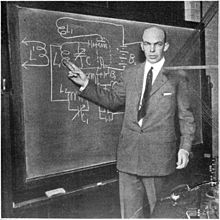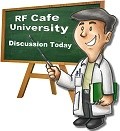|
<Previous
Next>
  One of my favorite old-time radio personalities,
Paul Harvey, had a trademarked feature titled The Rest of
the Story. For those of you not familiar with the format, Mr. Harvey would
begin his story talking about particular life aspects of a person that, while remarkable,
usually had no connection with the person's eventual claim to fame. The listener's
challenge was to guess who the person was before it was revealed at the very end,
followed by, "... and now you know --- the rest [emphasis] of the story."
As far as I know the story of FM radio inventor
Edwin H.
Armstrong was never a subject, although it certainly met the criterion. I've
already let the figurative
cat out of the bag, so you already know my subject. However, that
probably will not diminish the surprise at the end (for most people). One of my favorite old-time radio personalities,
Paul Harvey, had a trademarked feature titled The Rest of
the Story. For those of you not familiar with the format, Mr. Harvey would
begin his story talking about particular life aspects of a person that, while remarkable,
usually had no connection with the person's eventual claim to fame. The listener's
challenge was to guess who the person was before it was revealed at the very end,
followed by, "... and now you know --- the rest [emphasis] of the story."
As far as I know the story of FM radio inventor
Edwin H.
Armstrong was never a subject, although it certainly met the criterion. I've
already let the figurative
cat out of the bag, so you already know my subject. However, that
probably will not diminish the surprise at the end (for most people).
 You likely are familiar with the epic
struggle that Nikola
Tesla had with Thomas Edison in the contest between adoption of alternating
current (Tesla) versus direct current (Edison) as
the dominant electrical distribution system in America. It was a take-no-prisoners
battle that, as we know, had AC as the victor (see
War of the Currents). In the process, even with (eventually) the
powerful George Westinghouse as an advocate, poor Mr. Tesla was roundly abused with
character assassinations, lawsuits, publicity stunts, and financial trickery. He
spent the final years of his life in seclusion. You likely are familiar with the epic
struggle that Nikola
Tesla had with Thomas Edison in the contest between adoption of alternating
current (Tesla) versus direct current (Edison) as
the dominant electrical distribution system in America. It was a take-no-prisoners
battle that, as we know, had AC as the victor (see
War of the Currents). In the process, even with (eventually) the
powerful George Westinghouse as an advocate, poor Mr. Tesla was roundly abused with
character assassinations, lawsuits, publicity stunts, and financial trickery. He
spent the final years of his life in seclusion.
 Edwin Armstrong's
fate proved to be more tragic. Mr. Armstrong's notoriety was gained in 1914 the
as a result of his invention of the
regenerative
receiver circuit (patent 1,113,149). In 1922 he improved the basic function with
a superregenerative circuit design. Those two techniques allowed higher quality
reception for listeners already within reach of broadcast towers, and they allowed
people who had never been able to receive those signals to tune in for the first
time. This sold radio sets and provided a larger base of advertisers (who pay for
everything we enjoy for 'free') willing to underwrite expenses.
Lee de Forest,
whose name you probably recognize as the inventor of the
Audion amplifier vacuum tube, was awarded a patent for his own
version of a regenerative circuit in 1916, two years after Armstrong's. de Forest
sold his patent rights to AT&T and Armstrong spent decades and a lot of money
trying to regain control over his patent. Undaunted, he attacked the annoying susceptibility
of amplitude modulation (AM) to static electrical noise (lightning, motor brush
arcing, etc.) by developing frequency modulation (FM), which was patented in 1933
(patent 1,941,068). RCA Corporation, having
worked with Armstrong on FM radio broadcasting and reception, ended up in a legal
use rights fight with Armstrong, who wanted to license the technology rather than
sell his patents. Edwin Armstrong's
fate proved to be more tragic. Mr. Armstrong's notoriety was gained in 1914 the
as a result of his invention of the
regenerative
receiver circuit (patent 1,113,149). In 1922 he improved the basic function with
a superregenerative circuit design. Those two techniques allowed higher quality
reception for listeners already within reach of broadcast towers, and they allowed
people who had never been able to receive those signals to tune in for the first
time. This sold radio sets and provided a larger base of advertisers (who pay for
everything we enjoy for 'free') willing to underwrite expenses.
Lee de Forest,
whose name you probably recognize as the inventor of the
Audion amplifier vacuum tube, was awarded a patent for his own
version of a regenerative circuit in 1916, two years after Armstrong's. de Forest
sold his patent rights to AT&T and Armstrong spent decades and a lot of money
trying to regain control over his patent. Undaunted, he attacked the annoying susceptibility
of amplitude modulation (AM) to static electrical noise (lightning, motor brush
arcing, etc.) by developing frequency modulation (FM), which was patented in 1933
(patent 1,941,068). RCA Corporation, having
worked with Armstrong on FM radio broadcasting and reception, ended up in a legal
use rights fight with Armstrong, who wanted to license the technology rather than
sell his patents.
As with Nikola Tesla's predicament, a lifetime of legal battles and endless rounds
of defamation, deception, and other tactics finally broke the man. On January 31,
1954, Edwin Armstrong committed suicide by climbing out the window of his New York
City apartment and falling ten stories to his death. He was as meticulously attired
- suit, overcoat, scarf, gloves, and hat - for his death as he was known for being
in his life. "God keep you and the Lord have mercy on my soul," closed out the note
he left for his wife.
Now you know ...
See also "Major
Edwin Armstrong Receives Award from Army Signal Corps" in the August 1944 issue
of Radio-Craft.
Posted November 3, 2014
|



























 "
"



